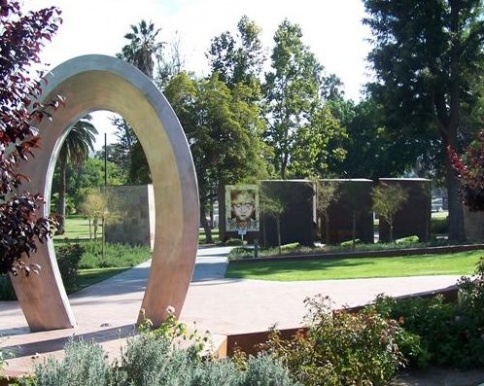
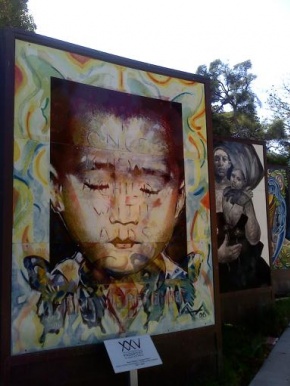
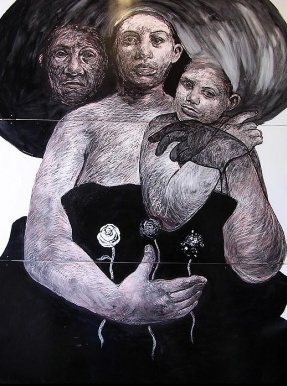
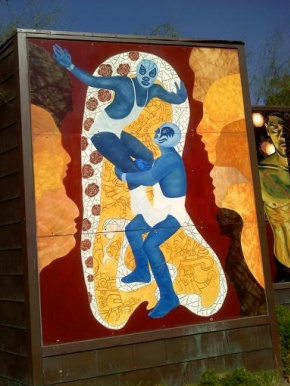
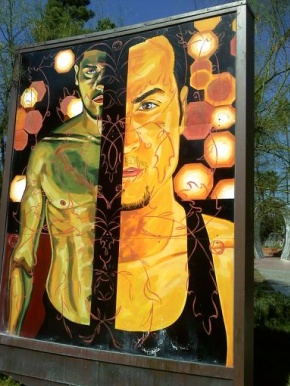
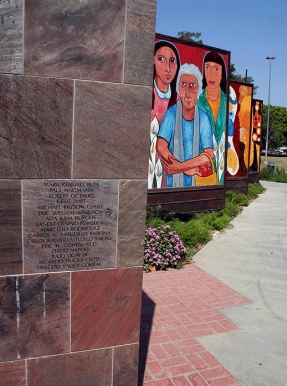
|
Los Angeles, CA United States |
Lincoln Park, 3600 N. Mission Road | The Wall Las Memorias |
since 2 December 2004 500 names |
Many of us know that Lincoln Park is home to Plaza de La Raza but did you also know that it is also home to the nation's first ever publicly funded AIDS monument?
This beautfiful project is the result of many years of labor from even many more family, community, volunteers, civic leaders, corporations and state officials coming together. Raza uniting to make sure that "The Wall--Las Memorias will be an eternal monument to honor our loved ones who have died of AIDS." Those were the first words I encountered on a memorial plaque as I approached the steel panels and monument that commanded my attention all the way from the north entrance of the park.
I walked around looking at the six mural panels and taking pictures of the magnificent, colorful images they depict. There are two granite panels that hold the names of people who have died of AIDS. I ran my hands through the names. Even though it was around 2:00 pm the park was nearly empty. Perhaps it merely felt that way in that serene, garden setting. The panels are arranged as a serpent, Quetzalcoatl, an Aztec symbol from rebirth. There are benches set in the garden area that allow for personal meditation. The total area of the monument is 9,000 square feet. But sitting on a bench, right next to a what I think is a lavender bush (Im terrible with flora and fauna and I only think it is lavender because of the purple sprigs and smell), this space feels larger, much larger.
I think about a friend in 1981 who died when this epidemic was just starting to claim lives in the thousands and thousands, and the public was just becoming aware. I think of my cousin who died almost a decade later in 1990 in Mexico and how no one in our family still to this day acknowledges that it was AIDS that claimed his life. When my aunt, his mother, was still alive she said it was stomach cancer. One painting in particular reminds me of him. It's a mural that's split in two. A man pictured from the waist up, walking towards the viewer, the lights in the background, his naked torso drawing your toward him then on the right, the face, the eye that captures how lonely it must have been for my cousin living his life in the closet.
But don't think that being here is only a downer. Yes, you come away with images of how it affects everyone, the mother, the child, how it is a lucha and the struggle continues. This arduous struggle captured by what else but two blue luchadores in a ying yang postition. The one that's about to be thrown ready for anything. You can't help but crack a smile and be hopeful that one day soon it shall be defeated. Photos © Liz Vega La Bloga
18 October 2009
Liz Vega, Los Angeles
This beautfiful project is the result of many years of labor from even many more family, community, volunteers, civic leaders, corporations and state officials coming together. Raza uniting to make sure that "The Wall--Las Memorias will be an eternal monument to honor our loved ones who have died of AIDS." Those were the first words I encountered on a memorial plaque as I approached the steel panels and monument that commanded my attention all the way from the north entrance of the park.
I walked around looking at the six mural panels and taking pictures of the magnificent, colorful images they depict. There are two granite panels that hold the names of people who have died of AIDS. I ran my hands through the names. Even though it was around 2:00 pm the park was nearly empty. Perhaps it merely felt that way in that serene, garden setting. The panels are arranged as a serpent, Quetzalcoatl, an Aztec symbol from rebirth. There are benches set in the garden area that allow for personal meditation. The total area of the monument is 9,000 square feet. But sitting on a bench, right next to a what I think is a lavender bush (Im terrible with flora and fauna and I only think it is lavender because of the purple sprigs and smell), this space feels larger, much larger.
I think about a friend in 1981 who died when this epidemic was just starting to claim lives in the thousands and thousands, and the public was just becoming aware. I think of my cousin who died almost a decade later in 1990 in Mexico and how no one in our family still to this day acknowledges that it was AIDS that claimed his life. When my aunt, his mother, was still alive she said it was stomach cancer. One painting in particular reminds me of him. It's a mural that's split in two. A man pictured from the waist up, walking towards the viewer, the lights in the background, his naked torso drawing your toward him then on the right, the face, the eye that captures how lonely it must have been for my cousin living his life in the closet.
But don't think that being here is only a downer. Yes, you come away with images of how it affects everyone, the mother, the child, how it is a lucha and the struggle continues. This arduous struggle captured by what else but two blue luchadores in a ying yang postition. The one that's about to be thrown ready for anything. You can't help but crack a smile and be hopeful that one day soon it shall be defeated. Photos © Liz Vega La Bloga
18 October 2009
Liz Vega, Los Angeles

























































